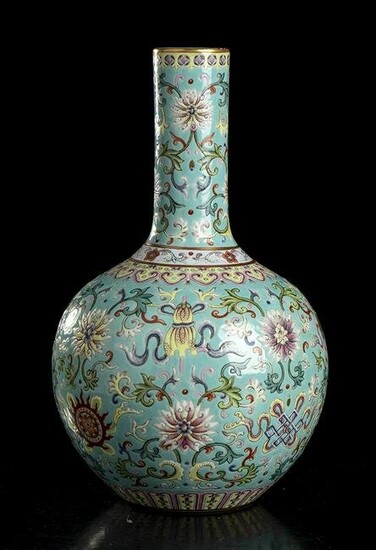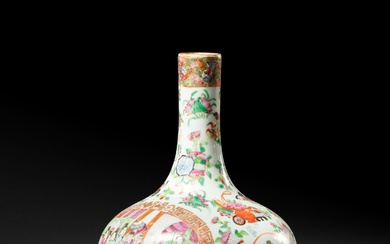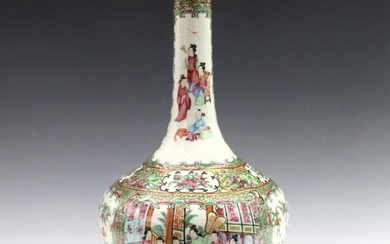A POLYCHROME PORCELAIN BOTTLE VASE, TIANQIUPING China
A POLYCHROME PORCELAIN BOTTLE VASE, TIANQIUPINGChina, 20th century
Circular section, the globular body supporting a long cylindrical neck, the external surface painted with touches of gold and polychrome enamels of tactile consistency with a decoration of stylized lotus flowers between which the Eight Buddhist Emblems, towards the base a band with paired stylized leaves, on the shoulder a band with ruyi scepter heads, Qianlong apocryphal six characters mark to the center of the base.33 cm highProvenance: Italian private collection.The 'Eight Buddhist Emblems' (å…« å‰ç¥¥, Bajixiang) are auspicious symbols originating in India, very popular in China, where they were introduced in the Yuan dynasty. These objects are associated with the life and teachings of the historical Buddha and used as liturgical tools.They are: the Wheel of the Law (è½®, mon), representing the eternal and painful cycle of birth, death and rebirth that can only be interrupted by following the path taken by the Buddha: the Conch Shell (螺, luo), symbol of purity and inalterity of the teachings of the Buddha, as well as a tool to gather the faithful; the Banner of Victory (è“‹, gai), emblem of victory and authority; the Ceremonial Umbrella (傘, san), a symbol of nobility, referring to the aristocratic origins of Sakyamuni and, above all, in relation to the nobility of his thought; the Lotus (è·èŠ±, hehua), the flower of purity; the Vase (ç½, guan), in which the elixir of immortality is contained; the Pair of Fishes (é±¼, yu), emblem of spiritual freedom; the Endless Knot (盤 é•·, panchang), to represent the cyclic nature of existence and therefore the need evoked by the Buddha to interrupt its infinite repetition.Despite the link with Buddhism, these eight objects have over time become a decorative motif with wider meanings, used in all areas of Chinese art.
Sale price
Estimate
Time, Location
Auction House
A POLYCHROME PORCELAIN BOTTLE VASE, TIANQIUPINGChina, 20th century
Circular section, the globular body supporting a long cylindrical neck, the external surface painted with touches of gold and polychrome enamels of tactile consistency with a decoration of stylized lotus flowers between which the Eight Buddhist Emblems, towards the base a band with paired stylized leaves, on the shoulder a band with ruyi scepter heads, Qianlong apocryphal six characters mark to the center of the base.33 cm highProvenance: Italian private collection.The 'Eight Buddhist Emblems' (å…« å‰ç¥¥, Bajixiang) are auspicious symbols originating in India, very popular in China, where they were introduced in the Yuan dynasty. These objects are associated with the life and teachings of the historical Buddha and used as liturgical tools.They are: the Wheel of the Law (è½®, mon), representing the eternal and painful cycle of birth, death and rebirth that can only be interrupted by following the path taken by the Buddha: the Conch Shell (螺, luo), symbol of purity and inalterity of the teachings of the Buddha, as well as a tool to gather the faithful; the Banner of Victory (è“‹, gai), emblem of victory and authority; the Ceremonial Umbrella (傘, san), a symbol of nobility, referring to the aristocratic origins of Sakyamuni and, above all, in relation to the nobility of his thought; the Lotus (è·èŠ±, hehua), the flower of purity; the Vase (ç½, guan), in which the elixir of immortality is contained; the Pair of Fishes (é±¼, yu), emblem of spiritual freedom; the Endless Knot (盤 é•·, panchang), to represent the cyclic nature of existence and therefore the need evoked by the Buddha to interrupt its infinite repetition.Despite the link with Buddhism, these eight objects have over time become a decorative motif with wider meanings, used in all areas of Chinese art.





